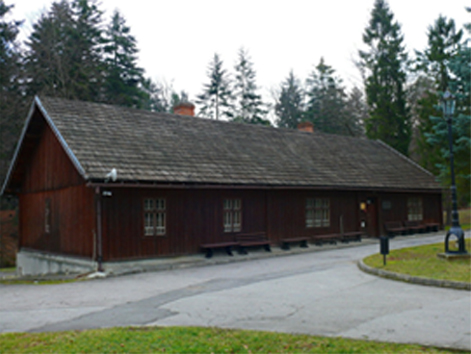



KOPALNIA ROPY NAFTOWEJ W BÓBRCE
Naturalne wycieki ropy naftowej występowały w lesie bobrzeckim od dawien dawna, jednak dopiero w 1854 roku powstała kopalnia i rozpoczęła się eksploatacja przemysłowa. Pionierami przemysłu naftowego, założycielami kopalni w Bóbrce byli: Ignacy Łukasiewicz – skromny farmaceuta; Tytus Trzecieski – ziemianin i inicjator założenia kopalni oraz Karol Klobassa-Zrencki – właściciel wsi Bóbrka. Dzięki zgodnej współpracy, zaangażowaniu oraz dużej operatywności twórców powstało pierwsze na świecie wielowymiarowe przedsiębiorstwo naftowe.
W ROKU 1853 DNIA 31 LIPCA po raz pierwszy publicznie zapalono lampy naftowe w szpitalu lwowskim na Łyczakowie. Data ta zapisała się na kartach historii jako symboliczna data NARODZIN PRZEMYSŁU NAFTOWEGO.
W 1854 roku Łukasiewicz został zaproszony przez Tytusa Trzecieskiego do Bóbrki, gdzie odkryto naturalne wycieki ropy naftowej, nazywanej w XIX wieku olejem skalnym. Trzecieski zaproponował założenie spółki naftowej, która zajęłaby się eksploatacją bobrzeckiego złoża. Rozpoczęto drążenie pierwszych kopanek- studni z ropą naftową. W 1855 roku w kopance „Wojciech” natrafiono na duży przypływ oleju skalnego. Następstwem odkrycia było założenie w 1856 roku destylarni w Ulaszowicach.
W 1861 roku powstała oficjalna, choć zawarta ustnie spółka naftowa. Trzecieski zainwestował wkładem pieniężnym, Klobassa ofiarował teren pod kopalnię, natomiast Łukasiewicz objął kierownictwo nad całym przedsiębiorstwem. W 1868 r. podczas wierceń w poszukiwaniu ropy naftowej natrafiono na duży przypływ wody solankowej. Karol Klobassa zlecił zbadanie składu chemicznego, który okazał się na tyle korzystny i cenny, iż właściciel kopalni postanowił wybudować domy zdrojowe i nieopodal kopalni ustanowić uzdrowisko, gdzie za darmo leczonoby wszystkich chętnych. W powstałym zakładzie wodoleczniczym wykorzystywano niezwykłe walory solanek pochodzących z szybów „Karol” i „Idzi”. Niestety dalszy rozwój kopalni spowodował, iż wód mineralnych było coraz mniej i z czasem uzdrowisko przestało istnieć.
Świetnie prosperujące przedsiębiorstwo zostało rozwiązane z inicjatywy Łukasiewicza w 1871 roku, gdy ten zrezygnował z 1/3 udziałów w spółce, pozostając przy funkcji dyrektora. Nadal prowadził rafinerię i kupował od wspólników surowiec do destylacji, ale nie pobierał dochodu z kopalni, która słynęła z doskonałej organizacji i nowoczesnych metod wydobycia. Robotnicy pochodzili z miejscowych wsi.
Zaczątkiem kopalni był rów o długości 120 m i głębokości 120 cm, który wykopano w miejscu zwanym Wrzankom, gdzie zaobserwowano obfite wycieki oleju skalnego. Łukasiewicz unowocześniał przedsiębiorstwo, korzystając z fachowych porad ówczesnych autorytetów z dziedziny geologii i wiertnictwa. W doskonaleniu metod wiertniczych pomagali Adolf Jabłoński i Henryk Walter, który wprowadził wiercenie udarowe z zastosowaniem nożyc wolnospadowych Fabiana. Dużym ulepszeniem było zastosowanie przez Alberta Faucka napędu maszyny parowej, która w znacznym stopniu wyeliminowała wysiłek ludzki i dała możliwość wiercenia do głębokości 240 m.
Łukasiewicz zajął się całkowicie przeróbką ropy, uzyskując wyjątkowo dobre gatunki nafty. Zainteresowali się nimi światowi potentaci w przemyśle naftowym. Produkty rafineryjne rozprowadzał w sklepach w Tarnowie, Krakowie i Warszawie. Osobiście zajmował się reklamowaniem produktów naftowych, biorąc udział w wystawach krajowych i międzynarodowych. Działalność przemysłową łączył z działalnością publiczną i społeczną.
Po śmierci Łukasiewicza, dyrektorem kopalni został Adolf Jabłoński, a następnie Zenon Suszycki. Kopalnia w Bóbrce przetrwała zawieruchy wojenne i w latach 50. XX wieku przeżyła ponowne odrodzenie, kiedy to na południowym fałdzie antykliny odkryto nowe złoże ropy. Na terenie muzeum znajdują się nadal czynne szyby naftowe.
10 grudnia 2018 r. na uroczystej gali zorganizowanej przez Kancelarię Prezydenta RP w Teatrze Narodowym, Bóbrka- najstarsza kopalnia ropy naftowej otrzymała tytuł Pomnika Historii.
Tym samym w Muzeum zakończono prawie dwuletnie starania o zaistnienie na prestiżowej liście najcenniejszych polskich zabytków. Jest wielkim wyróżnieniem nie tylko sam fakt nadania tytułu, ale również zaistnienie na liście ogłoszonej w 2018 r., która zgodnie z ideą Prezydenta RP stała się listą „100 pomników na 100 lecie odzyskania niepodległości”.
Status Pomnika Historii ustanawiany jest w drodze rozporządzenia Prezydenta Rzeczypospolitej Polskiej. Przyznawany jest zabytkom o szczególnej wartości historycznej i naukowej oraz mającym duże znaczenie dla dziedzictwa kulturowego Polski.
Nadanie obiektowi tytułu Pomnika Historii jest nie tylko wielkim wyróżnieniem, ale również warunkiem koniecznym do rozpoczęcia starań o wpis na listę światowego dziedzictwa UNESCO.
Potencjał kopalni w Bóbrce jest o wiele większy niż regionalny. Już dziś wiemy, że walory reprezentowane w Bóbrce są uniwersalne i mają wartość unikatową w obszarze dziedzictwa industrialnego całego świata.


